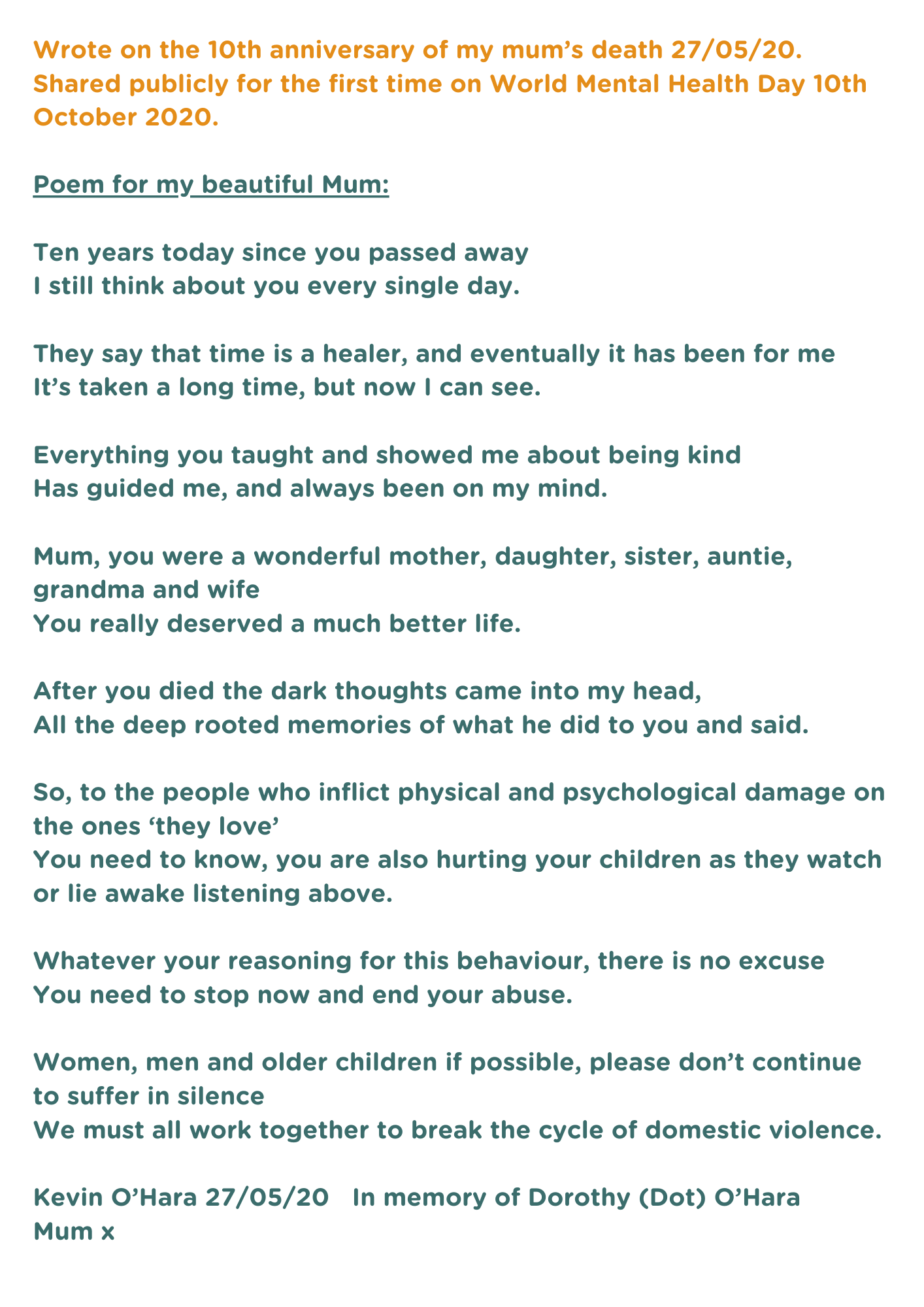A Poem for my Beautiful Mum
Survivor's Stories - Making the Difference
Emma's Story
Emma has experienced multiple and complex traumas throughout her life, including childhood physical abuse and sexual exploitation. During her pregnancy, she was referred to our service by the police at a time when she was also facing abuse from her partner. Understandably, Emma found it difficult to engage initially; her previous experiences had led to a deep mistrust of services, and she often needed space and time to feel emotionally safe enough to build relationships with professionals.
Children’s Services became involved during this period, which heightened Emma’s anxiety due to past interactions with statutory agencies. Despite the challenges she was navigating, Emma remained in contact with her partner, who was not only physically abusive but also exerted coercive control. This pattern of abuse created a dynamic of dependency and significantly impacted Emma’s ability to identify risk, separate safely, and make independent choices. This affected both her emotional and physical wellbeing and the safety of her unborn baby. As a result, a child protection plan was put in place.
Throughout this time, the IDVA and outreach worker provided consistent, trauma-informed, and non-judgmental support and safety plans. Their approach centred on building trust, recognising Emma’s strengths, and supporting her autonomy. Gradually, Emma began to engage more fully with the support offered and made the empowered decision to attend the AIM programme, taking important steps towards healing and safety.
After the birth of her baby, Emma moved into a mother and baby placement, where she received continued, tailored support that prioritised safety, stability, and emotional wellbeing. With ongoing encouragement and practical assistance, she was eventually able to secure and move into her own tenancy. Emma is now living free from abuse and is safely and confidently parenting her daughter in a secure and nurturing home.
Emma continued to access support during her final months with the service, including from a dedicated volunteer. Demonstrating her resilience and commitment to helping others, Emma has since chosen to volunteer with our service, using her lived experience to support and empower others navigating similar challenges.
Aisha's Story
The family were referred to our refuge a few years ago from a refuge in the midlands. The move took place as the perpetrator/dad was sighted in the local area and there was need to safeguard the family given the proximity of the area they had fled and the refuge they were placed in. the perpetrators work meant that he was driving in a 50-mile radius of his home increasing the risk to the family.
The family were initially placed in refuge after serious allegations were made regarding sexual and physical abuse by the paternal grandfather toward one of the children. One of the children disclosed to mum they witnessed inappropriate sexual contact by the paternal grandfather toward a sibling. This was then witnessed by mum herself. When she discussed this with her husband, he dismissed it as his dad messing around. A year later during a driving lesson, the victim disclosed the abuse to her instructor. Police were called, and she and her three children were relocated to a refuge. The case was dismissed due to insufficient evidence, though the disclosure itself reflects the ongoing safeguarding concerns for the family.
Only a few days after arriving at our refuge, the mother disclosed that threats to kill had been made by the perpetrator via a phone call to her sister in Turkey. These threats were reported to the police, and the Hate Crime Unit attended, completing relevant safeguarding actions and biometrics. The refuge IDVA conducted a DASH risk assessment, resulting in a score of 15. The case was subsequently referred to Multi-Agency Risk Assessment Conference (MARAC). Children’s Social Care became involved and issued a Statement of Expectations to the mother, which she signed. Mother suffered from complex trauma issues and there were concerns of reconciliation and the case progressed to a strategy discussion and Sec 47 enquires.
The family originate from the middle east where the mother experienced multiple complex traumas. According to the World Health Organization (WHO, 2022), women who are exposed to intimate partner violence and family trauma, especially in conflict-affected or patriarchal settings, are at a higher risk of experiencing mental health difficulties, barriers to service access, and social isolation.
Over 10 years ago victim’s brother was kidnapped and held for ransom. During his captivity, he was beaten, and the family sold their home to secure his release. Following this event, her father became addicted to drugs, lost his business, and became violent toward her mother, culminating in the murder of her mother. He later died while on the run. These events had a profound impact on the mother’s psychosocial wellbeing, her ability to trust, and her perception of safety/risk.
Shortly after, she was introduced to her husband by her sister. He was residing in the UK and had his own business. He had been previously married however sent his wife back to the middle east due to her not being able to have children. It later transpired he had an extensive history of Domestic Abuse including making threats to kill, has access to weapons, other violence and threats to kidnap. Although, this was an arranged marriage, there was also a lack of choice as victim felt she had no choice but to marry him due to limited support structures and no money to support herself. They married 10 years ago and initially resided in Afghanistan, the abuse started early within the relationship, and victim suffered emotional, verbal and physical abuse. They moved to the UK after a few years, and the abuse continued. Following a physical assault shortly after they had moved when pregnant she suffered a bleed and was taken to a private hospital for treatment and forced to say it was a result of a fall. Throughout the marriage, she endured escalating patterns of domestic abuse, including coercive control, emotional, psychological verbal, financial, physical abuse and domestic servitude. Her husband and his family controlled where she went, what she wore and whom she saw, and how she parented her children. Family members would take the children and keep them for several days and she could not refuse. She was isolated from her family, closely monitored, and coerced into silence. In 2017, following another physical assault resulting in a broken hand, she temporarily fled to a relative’s home but was pressured into reconciling. The abuse escalated, and disclosures made to the father-in-law were dismissed and blamed on her behaviour.
Since entering our refuge, mum had engaged consistently with support services. She engaged with the IDVA who has supported through both the CJS and Civil Justice systems and a Non-Molestation Order was applied for. The family are all registered with health services. The children are enrolled and settled into school and nursery. Mum engaged with education both DA awareness and ESOL classes and had applied for a college course. The family engaged with community activities that refuge provided. Mum had been supported to continue with driving lessons to foster further independence. Mum continued to engage with Childre services. The family have settled into their new home and received settling in support.
Mum has demonstrated resilience and a willingness to improve her situation. She has formed a supportive relationship within the community.
Despite the significant progress, due to the significant trauma suffered and the cultural issues professionals still have concerns of reconciliation and children have disclosed phone contact with dad. Further exacerbated by increased pressure, as dad has applied to the Family Court for contact with the children and this is currently being assessed by CAFCASS. Children services have concerns that mum may attempt to flee, or that dad will use the legal system to try and track the location of the family and proceedings have moved to the Public Law Outline (PLO). Mum struggles to understand and continues to question why Children services are taking legal action and describes the perpetrator as a loving dad. Mum has started to minimise the abuse and maintains she kept her children safe by leaving him. We are continuing to offer support to this family, highlight risks to her and encourage her to continue working with all services. Staff are aware that her responses could reflect trauma bonding, cultural expectations, and the normalisation of abuse. WHO research highlights that women from conflict-affected societies may internalise blame due to longstanding gender norms and lack of trauma education. Staff also recognise that there are still language barriers, though interpreters are provided, complex legal and child protection processes can still be overwhelming. Cultural stigma may hinder full engagement.
Staff continue to work with this family offering trauma-informed, culturally competent, and non-judgmental multi-agency approach to support. The mother's experiences of violence, forced dependency, and grief intersect with migration stress and unfamiliarity with UK safeguarding systems. Her minimisation of harm to her children reflects psychological survival strategies, fear of social ostracization from her family and her community and limited understanding of legal thresholds.
Memories from Childhood
This poem was forwarded to us by someone who remembers domestic abuse being inflicted on his mum, and him, during his childhood. Now, at 52 years old, the memories still linger.

